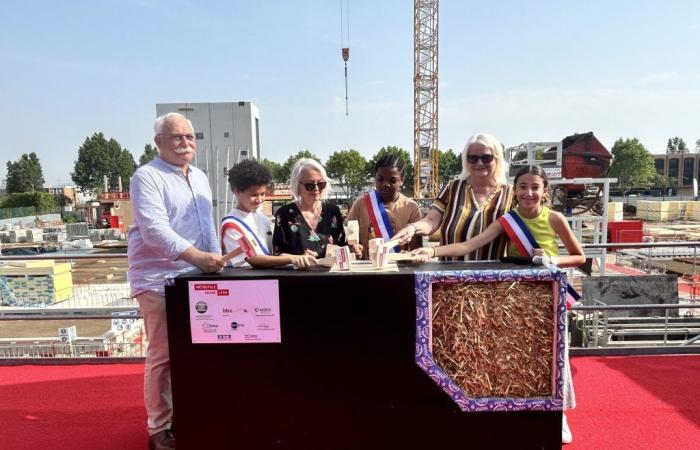The work started two months ago. The college is scheduled to open for the start of the 2025 school year.
The meeting was initially scheduled for early May; it had been postponed due to weather conditions. This Friday, June 28, the sun was shining for the installation of the first wall of the Katia Krafft college, located in Vénissieux, on the edge of Saint-Fons. While the first buildings are already emerging from the ground, Michèle Picard, mayor of Vénissieux, Christian Duchêne, mayor of Saint-Fons and Véronique Moreira, vice-president of the Metropolis, symbolically launched the start of the work.
This new 7,000 m² structure should open its doors at the start of the 2025 school year and will welcome nearly 730 students from Vénissieux and Saint-Foniard. The establishment will help improve the attractiveness of this sector and cope with the increase in school numbers and demographic growth. ” recalled Michèle Picard.
In both municipalities, the colleges are currently overloaded with occupancy rates reaching almost 110%. Good learning conditions, but also teaching conditions for teachers, must be met in working-class neighborhoods as in others. It is simply the application of common law, stressed the mayor of Vénissieux. It’s about to fight against a unequal access to knowledge and education, school dropouts, social determinism, still too present in France. »
82% of materials are biosourced
This colossal project costing almost 38 million euros is taking place on Avenue de la République and will transform the neighborhood within a few months, particularly with the arrival of the T10. “ It is not a minimum college that will emerge from the ground, but an ambitious college, with 32 classrooms, a school catering center, a school life center, a multipurpose room and ‘sporting activities. »
The future Katia Krafft college promises to be exemplary from an environmental point of view thanks to rigorous specifications imposed by the Métropole de Lyon. In total, 82% of the materials used are biosourced. 2,900 m³ of wood and 566 m³ of straw are necessary for the construction of the establishment. The carbon footprint of construction and energy is expected to be 25% lower than regulatory thresholds. Rainwater harvesting will be used for the college’s sanitary facilities and a retention basin will allow direct infiltration of rainwater from the buildings. “ I also wanted to emphasize the quality of the canteen, added Véronique Moreira. This is an exemplary management. It will produce organic, local, seasonal meals on site at controlled costs. »
Members of the Vénissieux Children’s Municipal Council were present to present some drawings: ” We worked on the image of the ideal college. For example, we want a college where people work hard, seriously and with a little more vacation. We want good friends, honest, kind and funny, and more outings. A college without harassment and a pleasant teaching team. » All these wishes were then sealed in a time capsule, then in one of the walls of the college so that future generations of schoolchildren will discover them in a few years.






